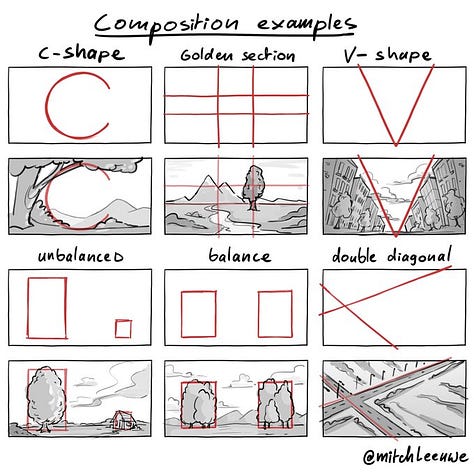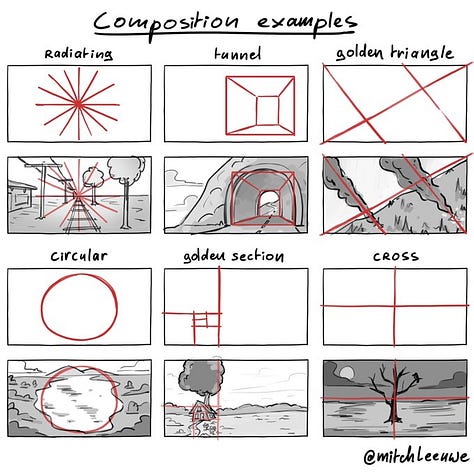18 Compositions to Challenge Yourself To
2 hours, 18 compositions. Can you do it?
A few months ago I stumbled upon this thread by Mitch Leeuwe on Twitter.
In this thread he mainly focuses on different drawing techniques he uses for his illustrations. Whether that’s a technique for backgrounds or where to place character eye-lines. The one thing that popped out the most to me, were the composition examples he brought attention to.
Not sure exactly what composition is? Here’s the ChatGPT definition.
Visual composition is the arrangement of visual elements within a frame, such as a photograph, painting or design, to create a balanced and pleasing image. It involves combining various elements such as color, shape, texture, space, and form in a way that guides the viewer's eye through the image and creates a sense of harmony and unity.
A well-composed image can evoke emotions and convey a message effectively. The use of techniques such as framing, rule of thirds, balance, symmetry, contrast, and perspective can help achieve an effective visual composition. These techniques can be learned and practiced to improve one's ability to create engaging and impactful images.
So let’s break this down a little bit more.
Composition is the arrangement of visual elements within a frame. It involves combining various elements like shape, color, space, and many other elements. These elements helps guide the viewer’s eye through the image.
The techniques such as framing, rule of thirds, balance, etc. can help achieve an effective visual composition.
Basically, composition is how you place your subject, background, and complimenting figures within your frame.
Awesome.
We can go into so many different tangents when it comes to composition. We can look into traditional painters and look into their work. We can look at still life paintings and see how artists arrange their work there. We can look at different directors and how they decide they want to place objects and people within their frame.
The main takeaway should just be that composition is how the artist arranges the different elements within their frame.
In his thread, Mitch brings to light different compositions I have never heard about.



Coming from a self taught, photography/videography background I didn’t know more than half of these even existed. But, looking at them it makes a lot of sense visually. Each rule brings a different type of visual intrigue to the frame. Can I express why I believe they work visually?…
Not really.
So for this week’s challenge let’s try to understand these composition examples a bit more.
The Challenge
What I am challenging you and myself to do is to turn these composition examples into a scavenger hunt. Try to create something new with each one of these compositions. Try to see how many you can do with one session.
If you want to draw something with that rule go for. If you want to take a picture with that rule go for it. If you want to film a video with that rule go for it. Just try out these different compositions and see how they work visually. See how you can apply these compositions to your work.
If you aren’t a visual creative, we can just start with the basic rule of thirds.
Take your phone, go to your camera settings and turn on the grid. There, you’ll be able to view the rule of thirds grid on your camera. Then just start aligning your photo subject along the lines and intersections of the grid. Look at the photos and see if there’s a difference in how your photos look.
Once you feel comfortable with that, try the same concept with the other composition examples. Just line up your photo with the suggested guidelines and see how it turns out.
My attempt:
What I learned:
Composition is pretty universal. I was a little skeptical as to how some of these would translate from a illustration to an image capturing. But, a lot of these turned out a lot better than expected. The ones I liked the most were L-shape and S-shape.
It’s very relaxing to take some time to slow down and intentionally set up your shot. During this whole year, I’ve been very much run and gun when it comes to shooting. I’ve been focused on the subject of the shot more than the composition of the shot. It was a good change of pace.
Look for shapes when composing your images. Shapes bring a familiarity to our eyes. They ease our eyes and relax our minds.
Tips for the scavenger hunt: (camera)
Go for the compositions you are most comfortable with at the beginning
Bring a tripod if you can that way you can more precisely set up your shots
Block out 2+ hours for the challenge
Conclusion:
It’s a really fun and challenging scavenger hunt. I personally think it is good for all skill levels. You do not need to get to every single composition in one session. If you can, that’s awesome. But if you can’t, you are still training your brain to look at images in a different light. You are now exposed to these different compositions and can aim for those in the work you do in the future.
You lose nothing by attempting this challenge. If you’re more advanced, try to tell a coherent story using these compositions. Storyboard a short story using every composition type above. That could be fun.
If you’re a beginner, just try to see if you can just achieve some of the compositions.
Just have fun with it. Challenge yourself and see what comes out of it.
Sharing:
If you’d like to share your work with us. You can share on your socials and tag us:
instagram: @simplex.minds
twitter: @simplexminds
or dm us what you create! We’d love to see all of your work.
Thank you for your support!
Thank y’all for being a part of our little creative club here. We just launched our shop, if you’d like to help support us we’re selling some hoodies. Share the challenge if you’d like. Also subscribe for more in the future! We plan to send out different types of creative challenges every other week!
Much love,
Troy



